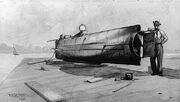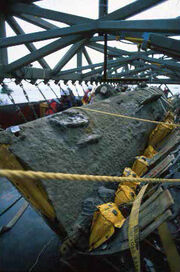CSS H.L. HUNLEY (1863)
Built: Mobile Bay, Alabama

Sketch of the Hunley based upon contemporary accounts.
Commissioned: August, 1863
Service: Charleston Squadron, 1863-1864
Home Port: Charleston, South Carolina
Dimensions: 39.5' Length, 3' 8" Beam
Armor: None
Armament: Spar Torpedo

Hunley being raised her in her specially constructed cradle, 2000.
Engines: Hand-Cranked Propeller
Speed: 4 knots
Crew: 8
Fate: Sank, February 17th 1864.
Summary
H.L. Hunley was named for her inventor, Horace L. Hunley, who had previously designed at least two other submarines (Pioneer and CSS American Diver.) It was the third such project designed by Hunley specifically for the Confederacy and the second to be comissioned into official military service. She earned her commission after successfully being tested in the sinking of a coal barge in Mobile Bay, and was thereafter shipped via rail to Charleston.
The Hunley was designed to operate via a hand cranked propulsion system, submerging just under the surface to attack a target ship and then return safely to friendly waters. The original weapon envisioned was a towed explosive charge, which the Hunley would lay next to or under a target ship before moving on to safety, but this was soon abandoned as being too dangerous for the Hunley itself. The methodology chosen instead involved the attachment of a barbed spar torpedo, implanted in the hull and detonated from within the Hunley itself. The precise mechanisms for this method aren't quite clear, and may yet be discovered over the course of the preservation work on her wreck.
Hunley was first tested operationally in August, 1863. The operation was a disaster, as the ship's acting commander, Lieutenant John A. Payne, accidentally stepped on the ballast lever, causing the vessel to submerge without sealing its hatches and killing five of the eight crew. Her second operation, a mock attack, took place in October, 1863, this time ending when Hunley failed to surface, taking the life of her inventor and namesake along with the rest of the eight members of the crew. Nevertheless, the CSN salvaged the vessel on both occasions and immediately put it back into service. Descriptions of the bodies from the second sinking of the Hunley were published in contemporary sources, and are quite disturbing to say the least. Nevertheless, Hunley's crew seemed to have no shortage of volunteers.
On February 17th, 1864, Hunley was used in her first and only operation against a live target, with an attack on USS Housatonic, a sloop of war, part of the Union blockade just off the South Carolina coast. The attack proceeded swiftly and without much interference by Housatonic, the spar torpedo embedding in the side of the hull and exploding to take the target ship down in a few short minutes, though most of its crew survived. Shortly thereafter, Hunley disappeared. The cause of her sinking is, as yet, unknown.
Originally, it was believed that Hunley was sucked down by the force of Housatonic's rapid submersion, but this seems to have been inaccurate, since there is good evidence that Hunley was operational for at least one hour after the attack. Other theories are that Hunley was swamped by a rescue ship sent to retrieve the Housatonic, or perhaps even to tow her back, or that she settled to the bottom, and the exhausted crew drifted off to sleep, aspyxiating before they could revive and return to the surface. The bodies discovered in the wreck were found still at their stations, without any signs of a struggle or distress, this may lend creedence to the latter theory.
In 2000, the Hunley and her crew were rediscovered and raised near Charleston. The wreck is now undergoing careful research and restoration, and her crew have since been given military burials (described as the first Confederate burials in nearly 150 years).